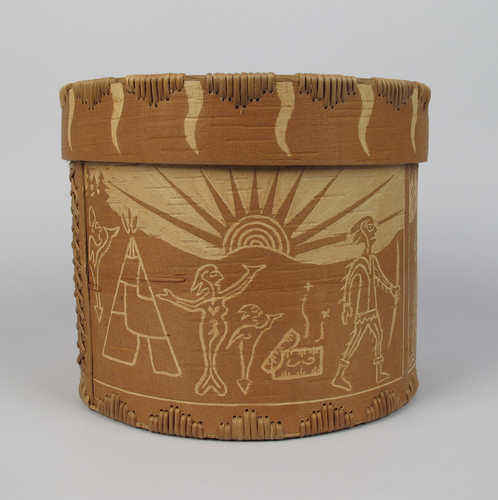Keywords: Passamaquoddy Indians.
Item 80735
Collar box and collars, Passamaquoddy, ca. 1880
Contributed by: Abbe Museum Date: circa 1880 Media: Birch bark, spruce root, sweetgrass, linen
Item 80748
Picture frame, Passamaquoddy, ca. 1900
Contributed by: Abbe Museum Date: circa 1900 Media: Birchbark, ash, sweetgrass
Exhibit
Passamaquoddy Indians from Washington County traveled to Portland in 1920 to take part in the Maine Centennial Exposition. They set up an "Indian Village" at Deering Oaks Park.
Exhibit
Gifts From Gluskabe: Maine Indian Artforms
According to legend, the Great Spirit created Gluskabe, who shaped the world of the Native People of Maine, and taught them how to use and respect the land and the resources around them. This exhibit celebrates the gifts of Gluskabe with Maine Indian art works from the early nineteenth to mid twentieth centuries.
Site Page
Mount Desert Island: Shaped by Nature - The Indian Encampment
"… Commission Rusticators were curious about the Passamaquoddy and Penobscot families who encamped every summer at Bar Harbor."
Site Page
Mount Desert Island: Shaped by Nature - The Indian Encampment: Behind the Scenes
"The Indian Encampment: Behind the Scenes Indian encampment, Bar Harbor, 1881Abbe Museum All the cooking at the Indian encampment is done…"
Story
The centuries-long history of Passamaquoddy Veterans
by Donald Soctomah, Passamaquoddy Historic Preservation Office
Passamaquoddy Veterans Protecting the Homeland
Story
Wampum Belts
by Donald Soctomah
My great grandfather was a wampum keeper
Lesson Plan
Nation to Nation: Treaties and Legislation between the Wabanaki Nations and the State of Maine
Grade Level: 9-12
Content Area: Social Studies
This lesson plan asks high school students to think critically about and look closely at documentation regarding the Nation-to-Nation relationship between the Wabanaki Tribes/Nations and the State of Maine. This lesson asks students to participate in discussions about morality and legislative actions over time. Students will gain experience examining and responding to primary and secondary sources by taking a close look at documents relating to the Maine Indian Claims Settlement Act of 1980 (MICSA) and the issues that preceded and have followed the Act.
Lesson Plan
Grade Level: 3-5, 6-8, 9-12
Content Area: Science & Engineering, Social Studies
This lesson plan will give middle and high school students a broad overview of the ash tree population in North America, the Emerald Ash Borer (EAB) threatening it, and the importance of the ash tree to the Wabanaki people in Maine. Students will look at Wabanaki oral histories as well as the geological/glacial beginnings of the region we now know as Maine for a general understanding of how the ash tree came to be a significant part of Wabanaki cultural history and environmental history in Maine. Students will compare national measures to combat the EAB to the Wabanaki-led Ash Task Force’s approaches in Maine, will discuss the benefits and challenges of biological control of invasive species, the concept of climigration, the concepts of Traditional Ecological Knowledge (TEK) and Indigenous Knowledge (IK) and how research scientists arrive at best practices for aiding the environment.
















